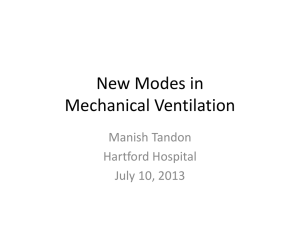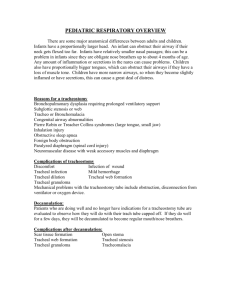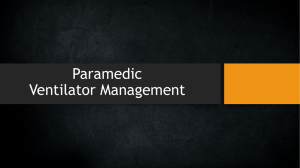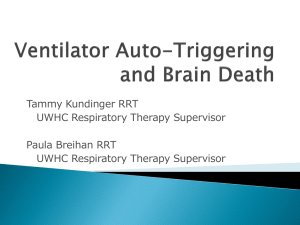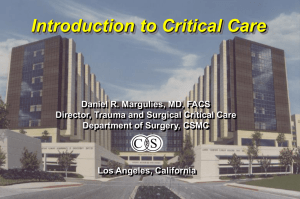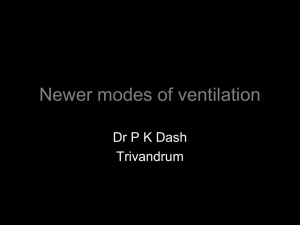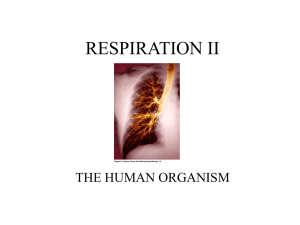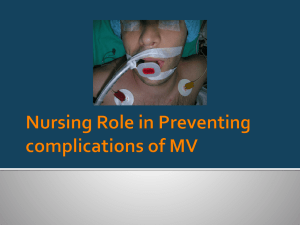File - Bristol Regional Medical Center Kings Mountain
advertisement
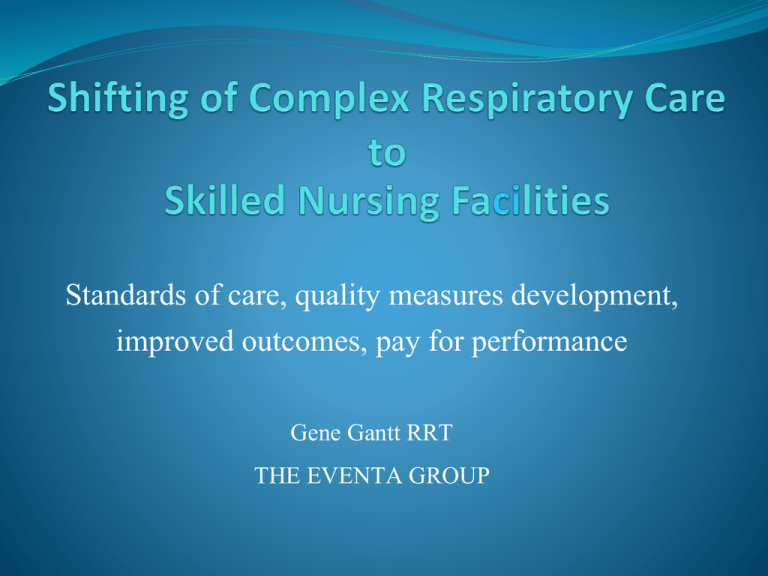
Standards of care, quality measures development, improved outcomes, pay for performance Gene Gantt RRT THE EVENTA GROUP Eventa=Latin for outcomes Long Term Care Market 16,000 SNFs 1724 new vent beds in SNF from 2009 to 2013 -US total 9500 U.S. shipments of sub-acute ventilators 6,789 units in 2017, up 41 percent from 4,805 in 2013, according to IHS Technology (NYSE: IHS 1.5 million residents 25-30% with lung disease Predicted Increase in PMV cases - 490,000 in 2010 to over 600,000 cases in 2020 The need to cut down on readmission has spurred the expansion of subacute ventilator market Past Model in Long Term Care Prior to the early 1990s Complex Respiratory patients were cared for in the hospital and in the ICU, especially those on mechanical ventilation Skilled Nursing Facilities (SNFs) were primarily custodial care sites until the mid 1990s when more complex patients began to be transferred to unorganized “Sub Acute” units with little technology available In 1998 with the advent of PPS, SNFs eliminated most high acuity programs leaving hospitals with no downstream discharge options except home Many patients were being discharged home on mechanical ventilation with no chance of liberation and at a high cost to the state and federal payers The SNFs who did accept ventilated patients offered little or no hope of liberation from the vent nor had any emphasis on outcomes State Medicaid's had the concept that these patients had been unweanable and therefore paid SNFs a very low rate per day and as a result this population most often became “warehoused”, and still are today in most states Shift of Complex Respiratory Care to Skilled Nursing Facilities With approximately 16,000 nursing homes in the US comprising 1.7 million beds (1.5 million residents) the LTC segment is undoubtedly the largest single expansion site for the care of the complex respiratory population. Approximately 25% of these 1.5 million residents have underlying pulmonary disease or compromise. The American Health Care Association reports a growth 0f 1724 vent beds in Skilled Nursing Facilities from 2009 to 2013 bring the US total to 9500. In from 2002 to 2010 there were 3 vent units in TN with 48 beds. From 2010 to 2014 the number of sites tripled to 9 and number of beds quadrupled to 222. The shift in sites of care has preceded the efforts to improve quality and standards of practice The pressure on hospitals to discharge and avoid readmissions has become a struggle as SNFs were and are still somewhat unprepared for the complexity of the population especially in light of often low Medicaid rates Current US standards No state to state consistency in standards for complex respiratory and ventilator care Standards and payments vary by state There has been little focus on quality metrics and oversight The major shift from ICU and hospital to Skilled Nursing Facilities proceeds at a furious pace and SNFs have little guidance SNFs lack standards requiring advanced noninvasive technology (high flow systems, airway clearance devices, and monitoring. Many lack appropriate personnel (Medical Direction and Respiratory Therapist) Our journey to improve outcomes Timeline 2002 opened first SNF vent unit in TN – 85% pts weaned first year Reported results to Governor –gained support for reimbursement 2004 Developed standards of care – endorsed by TSRC 2005 standards endorsed by TN Board of Respiratory Care 2009 standards adopted as rules for NF by Board of Health Care Facilities and TN Medicaid 2010 standards developed into national recommendation - position statement by AARC 2011 TN SNF vent program maintains 63% wean rate recognized by ACCP as Best Practice/Center of Excellence 2014 Engaged by TN Medicaid to develop quality metrics and design a Pay for Performance model Enhanced Respiratory Care In Tennessee ERC refers to the following special levels of reimbursement for services in a NF: Chronic Ventilator Care Ventilator Liberation or Weaning Tracheal Suctioning History of Enhanced Respiratory Care Pre-ERC Program (1998 – 2002) • SNFs unwilling to accept high acuity, high-cost patients needing ventilator care due to: Medicare conversion from cost-based reimbursement to RUGbased per diem prospective payment system Medicaid facility-wide cost-based payment methodology that failed to cover higher costs of residents needing ventilator care • The first SNF based ventilator unit was established in 2002 During the first year liberated 60 out of 92 patients were liberated from ventilators (deemed “un-weanable”) Led to research of best-practice and cost-effective approaches to ERC History of Enhanced Respiratory Care • Development and Evolution of ERC Program (2003-2010) Standards of Care developed and incorporated into HCF rules for SNFs providing ventilator care Two additional ventilator units began operations (1 in each Grand Region); rates negotiated with MCOs Liberation rates at 65% • Recent History (2010-2013) In 2010, Medicare revised per diem rates from average of $350 to $700 During that same year, as part of CHOICES program, TennCare established ERC rates to SNFs delivering ERC services • 2010-2014 Number of sites grew from 3 - 9 Beds from 48 - 222 Current initiative Although TN adopted standards of care in 2004 we are currently engaged in the next step which is to require accountability and quality monitoring in facilities receiving TennCare funds TennCare is currently evaluating metrics to be utilized in a pay for performance model in SNF ventilator units encouraging outcomes and the use of noninvasive technology. Currently a review and redesign of the medical necessity for ventilator care is underway in conjunction with the CMO of TennCare Additionally there is a review of patient data of those on home ventilation Value Based Purchasing Payment Reform – specific amounts TBD Threshold Measures - required in order to be eligible to receive ERC payments (base rates and P4P components) Facilities must continue to meet 100% of Threshold Standards of Care Includes Timely Reporting of Key Performance Indicators Quality Measures Pay for Performance component that incentivizes Ventilator Weaning and improved quality performance and outcomes may be earned in addition to base rates Key Performance Indicators Census by type (vent or trach) Number of ERC patient referrals vs. admissions Number of out-of-state referrals Number of admissions by payer source Number of admissions by diagnosis (vent or trach) Number liberated from ventilator Number decannulated Number discharged from ERC services and disposition Number transferred to hospital (and whether or not they returned to the SNF) Sentinel events + Unexpected death in facility Number of patients with respiratory infection requiring isolation Pay for Performance Component Quality Measures consisting of Quality Indicators and Technology Indicators will be used to determine quality payments (thresholds, point values and payments to be established). Quality Indicators (to incentivize quality performance and outcomes) Annual Ventilator Wean Rates Average Length of Stay to Wean Infection Rates Unplanned Hospitalizations Decannulation Rate Unplanned Deaths Denial Rate Pay for Performance Component Technology Indicators (incentivize use of modern technology) Cough Assist High Flow Molecular Humidification Alarm paging or beeper system Non-Invasive Ventilation (volume) Non-Invasive Open Ventilation High Frequency Chest Wall Oscillation or IPV Heated Wire Circuits Incentive Spirometer or any PEP Therapy Weaning rates in SNF We, along with others have demonstrated that a majority of the patients deemed ventilator dependent can still be liberated for the mechanical ventilation. This effort requires appropriate personnel, technology, monitoring, mobilization and nutrition. 1996-Latriano B , Chest 51% 2000-Gracey DR, Mayo – 60% 2002-Gene Gantt, Report to Governor Bredesen, TN initial vent program 85% 2004 Dr. Mark Lindsay, Mayo 67% 2011- Gene Gantt, ACCP Chest Conference Center Of Excellence presentation, TN vent program 65% statewide Summary It has become a mission to change the paradigm of complex respiratory and ventilator care in the post acute arena. As clinicians, we have seen first hand the positive effect of appropriately modeled care in the post acute space. We take pride in the fact that Tennessee is a leader in developing quality long term care programs. Other states have taken interest and are following our lead or contemplating engaging us to develop similar programs with them. In addition to the high complexity population, we recognize the potential to dramatically decrease hospital admissions in the general SNF population. We feel there are tremendous opportunities for low cost interventions that will greatly reduce the incidence of aspiration pneumonias and other respiratory issues in the general resident of the SNF. The End Questions?
